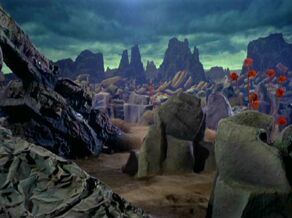Extollager
Well-Known Member
- Joined
- Aug 21, 2010
- Messages
- 9,229
Star Trek fans remember the series' two-parter, "The Menagerie." Perhaps it offers a way to get into the meaning of Lovecraft's story.
In the Star Trek teleplay, the two principal characters are Captain Pike and Vina. They are both incapacitated and disfigured because of accidents. Nothing that the culture of their time offers could restore them. However, the telepathic residents of the planet Talos can project into their minds the shared illusion that they are healthy and beautiful, and, despite their injuries, free to roam hand in hand amid splendors drawn from their own memories and fantasies or dreams. (Talos is actually a grim world.) The telepaths' motives for their captivity of the humans are not completely clear; at times, if I recall correctly, they appear to derive gratification from a voyeuristic participation in the sensations of others, while we are to take it that they are compassionate at the end of the teleplay.

In Lovecraft's story, Randolph Carter is emotionally and imaginatively maimed. Modern science has exposed the meaninglessness of existence; the cosmos thus revealed is, insofar as human feeling is concerned, a barren wasteland, like the surface of Talos. It can never provide that for which his soul yearns. However, Carter remembers a boyhood sense of enchantment as he roamed a rural landscape, and he is a dreamer, too. The silver key of the story corresponds to the Talosians; it is the means by which Carter can live again in the worlds of his dreams and memories, and we learn at the end of the story that, like Pike with his Vina, Carter shares in a dreamworld with the narrator. The erotic element in the teleplay was something foreign to Lovecraft's imagination, who prized instead male friendship, such as the narrator and Carter share. Both Pike and Carter, I take it, will remain within the cycles of their splendid dreams and memories, with their companions, till death.
 The provenance and nature of the silver key is uncertain. Lovecraft ends the story with a paradoxical line about "the aims [sic] and mysteries of a blindly impersonal cosmos."
The provenance and nature of the silver key is uncertain. Lovecraft ends the story with a paradoxical line about "the aims [sic] and mysteries of a blindly impersonal cosmos."
In the Star Trek teleplay, the two principal characters are Captain Pike and Vina. They are both incapacitated and disfigured because of accidents. Nothing that the culture of their time offers could restore them. However, the telepathic residents of the planet Talos can project into their minds the shared illusion that they are healthy and beautiful, and, despite their injuries, free to roam hand in hand amid splendors drawn from their own memories and fantasies or dreams. (Talos is actually a grim world.) The telepaths' motives for their captivity of the humans are not completely clear; at times, if I recall correctly, they appear to derive gratification from a voyeuristic participation in the sensations of others, while we are to take it that they are compassionate at the end of the teleplay.

In Lovecraft's story, Randolph Carter is emotionally and imaginatively maimed. Modern science has exposed the meaninglessness of existence; the cosmos thus revealed is, insofar as human feeling is concerned, a barren wasteland, like the surface of Talos. It can never provide that for which his soul yearns. However, Carter remembers a boyhood sense of enchantment as he roamed a rural landscape, and he is a dreamer, too. The silver key of the story corresponds to the Talosians; it is the means by which Carter can live again in the worlds of his dreams and memories, and we learn at the end of the story that, like Pike with his Vina, Carter shares in a dreamworld with the narrator. The erotic element in the teleplay was something foreign to Lovecraft's imagination, who prized instead male friendship, such as the narrator and Carter share. Both Pike and Carter, I take it, will remain within the cycles of their splendid dreams and memories, with their companions, till death.

